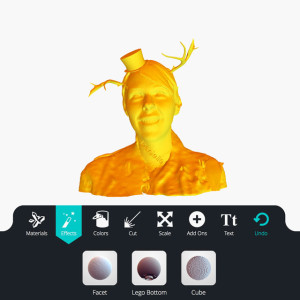It’s become somewhat obvious that, for 3D printing to be adopted by the mainstream, there needs to be some 3D modelling software with more of a learning plane than a learning curve. While we’ve seen a number of contenders enter the market with shape-based modellers, like Tinkercad; and sculptors, like Leopoly, those programs don’t quite offer the functionality we’re looking for. It’s still in beta, but a new cloud-based software called MatterRemix, proposes to lay the groundwork for a new way of thinking about 3D modelling.
“We start with the assumption that content creation is hard and that most people’s creativity exceeds their ability to realize their ideas in a meaningful way,” says MatterRemix CEO, Dylan Reid. “Those problems are more acute in 3D design where space is difficult to navigate. Our ultimate goal is to be able to match people’s inherent creativity and taste with tools that will let them materialize their ideas in physical form. That’s a tall order for a general tool but one we’re committed to accomplishing.” I believe that it’s Dylan’s straight forward attitude (as evidenced in MatterRemix’s terms of service), combined with a knowledge of human potential, that yields a nascent product with a good deal of promise. The idea behind MatterRemix is incredibly simple, but could unleash a user’s creativity quite quickly. Just take a look at what I did to an uploaded Kinect scan I made of my friend Ben:
Dylan explains that the software is, in some ways, similar to Instagram, in that they’ve designed a series of filters and tools that are easily applied to a 3D model. In the above example, I’ve chopped off an uneven portion of the base of Ben’s bust, colored him green, and attached some MatterRemix add-ons (try to guess which things aren’t native to Ben!). I can even format the bottom of my model to become Lego-compatible, making it so that I can attach Ben to a Lego car, for instance, and drive him around making honking noises and yelling “Get outta the way!” And all of this is done quickly and easily (the model remixing, not the lego-ing, though I’m pretty good at playing with Legos, as my nephew can attest). The CEO describes the user interface in this way:
We’ve taken our greatest inspiration from 2D design tools and think there’s a lot of lessons to be learned from their evolution. At one point photo editing was something only a small group of people engaged in and now with Instagram and Aviary, it’s something nearly all of us have contact with. There are obvious differences between the 2D and 3D design, but we think the analogy is instructive when it comes to user experience. What’s magical about photo filters, that is completely missing from the 3D world, is the ability to make meaningful transformations with the click of a button. As we look beyond where we are now, into the future of personal fabrication, we see a lot more 3D design working this way: reducing complex functionalities to the click of a button or the push of a slider bar.
As a CAD novice, I’ve struggled with complex and simple 3D modelling software. Blender’s interface, for me, seems counterintuitive and I hate playing with blocks (Tinkercad, not Lego). And, when I want to do something that seems simple on a superficial level, like fuse two different meshes together (to merge together scans I made with the Kinect or to put Danielle’s head on a lion’s body), Meshlab can be unintelligible. With MatterRemix’s future developments, these frustrations may be a thing of the past. Dylan tells me that the next revision to their software will allow for more input on the part of the user and the community that could help alleviate my troubles:

With the next set of features, we’ll be giving users more control over how they’d like to modify their models — letting them upload their own content, create their own filters, etc. and if the community wants it making it easier to share and exchange the things they made. We’ll also be diving into 2D to 3D conversion as we’ve found a lot more people have the ability to create 2D assets (photographs, illustrations, etc.) than 3D.
The service is free, as it stands, but because it is “pretty computationally intensive, we may charge some sort of subscription fee to cover the costs”, though Dylan offered to let our readers register accounts that will remain free indefinitely. As far as the core business model is concerned, he explained that their money-making plans are as follows: “From a business perspective, MatterRemix is really just a testing ground where we can try out new features and stress test technology we’re building. Our real interest is letting other people — designers, brands, services — use our technology to power the next generation of content applications. We’re working on an elegant way to run our mesh modeller in the background of different sites and services and we’ll be rolling out some very cool collaborations soon. Stay tuned!”
If you’re interested in becoming a beta developer for MatterRemix, you can fill out the form here or e-mail [email protected]. Then, maybe you can incorporate some much-needed soft-lighting, sepia, and rounded corner filters into the app to ensure its popularity among the Instagram crowd.


